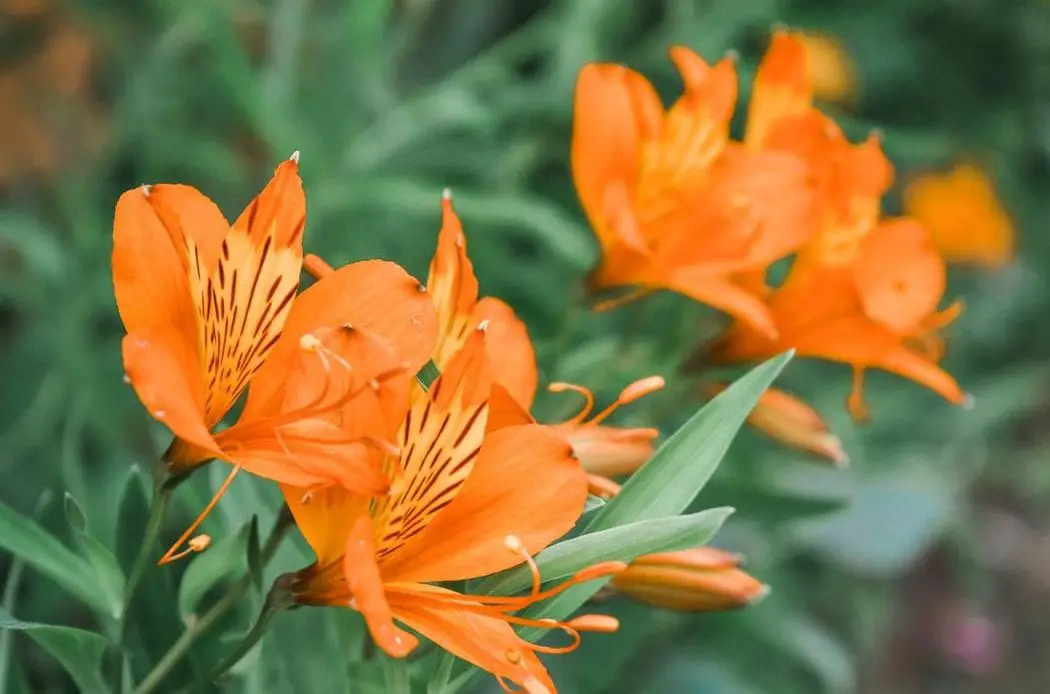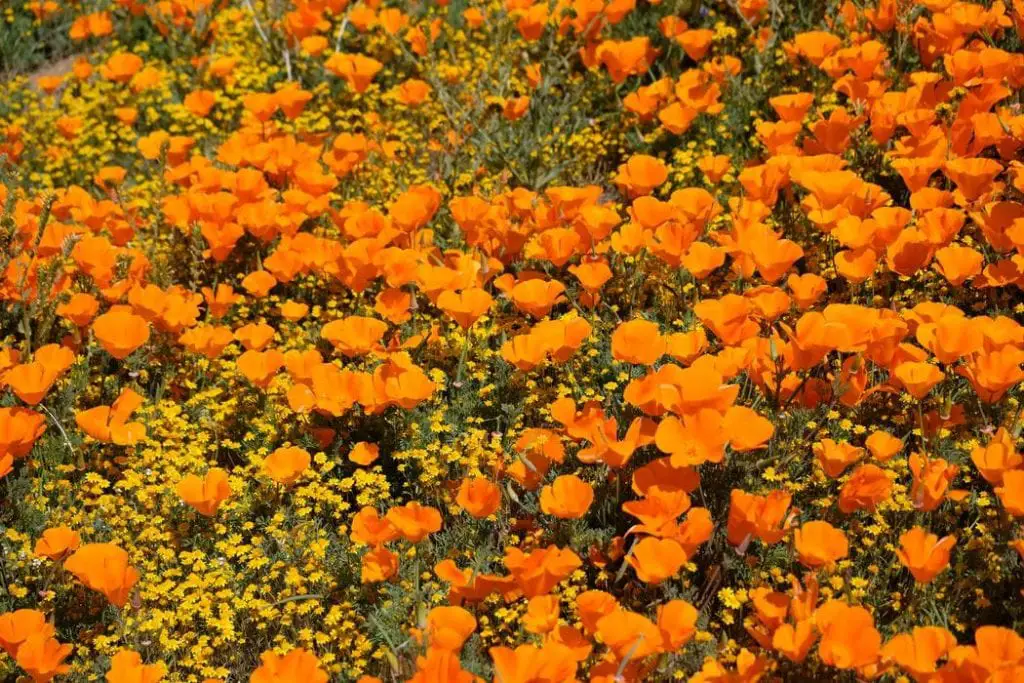
A garden in front of your house is a relaxing sight. Maintaining a garden can be a stress-busting activity. Different colors and varieties of flowers add to the vibrant feel of the garden. Orange flowers look fresh and are sure to bring you loads of compliments.
Let’s look at some orange flowers which you can grow in your garden.
Types of Orange Flowers.
1. Marigold
Marigolds are easy to grow and bring bright sunshine to your garden. They require sunlight and well-draining soil. They bloom from late spring till fall. There are around 50 species of marigold. The flowers bloom in shades of orange and yellow.
Marigolds are ideal flowers for first time gardeners. The seeds of marigold germinate quickly and within 8 weeks you can see the orange flowers bloom on the plants. Their flower heads resemble carnation flowers and the petals are arranged in chunky layers.
2. Orange Lily.
Also called Fire Lily, Lilium aurantiacum or Lilium croceum. This showy plant belongs to the lily family. Its blazing orange flowers have a height of 4-6 centimeters. The petals have reddish-brown dots with red tips. This plant is native to Southern Europe.
The orange lily does not require too much care and multiplies quickly. The bloom period is in early summer. This lily can be grown in containers also. The plant grows up to a height of 3-4 feet (1.22 m) and requires well-drained but moist soil for growth.
3. Zinnia
The zinnia plant blooms from late spring till winter. These low maintenance plants are ideal for first-time flower growers. Zinnia is a quick-growing plant and you can expect bright blooms within 60 days of planting the seed.
All you have to do is find a spot where the plant can get some sunlight daily and some well-drained soil and you are good to go. Periodic removal of faded blooms and the use of light fertilizers ensures continuous flowering.
4. Dahlia
Dahlia is a member of the Asteraceae family. Dahlia has blooms in a variety of colors and sizes. The orange dahlia looks grand and adds a rich look to your garden. They are not suited to very hot regions.
Dahlias grow well in moist, moderate temperatures. The plant requires direct sunlight. When planted in rich, well-drained soil the tubers start blooming in about 8 weeks after planting. Dahlias don’t grow well in cold climates.
5. Cosmos
Cosmos bipinnatus have daisy-like flowers. The plant grows from 1 to 4 feet (1.22 m) and has delicate, small orange flowers. This plant is a native of Mexico and the Southern United States. The flowers bloom annually from summer through fall.
This is a tough plant capable of withstanding lack of water, poor soil and neglect. Cosmos plants are easy to grow and can be planted by simply scattering the seeds in your garden. They grow effortlessly in beds and are a great choice for cut flowers. This is a self-seeding plant. Cosmos is known to attract birds and butterflies to the garden.
6. Begonia
Bolivian begonias are natives of the eastern sides of Andes mountains in Bolivia and Argentina. Begonia family is quite expansive with more than 1500 species. The “Bonfire” species is most popular among begonias. This species produces brilliant orange flowers. The flowers bloom in twos or threes. Begonia flowers have four pointed segments flaring at the ends, which fall off naturally. The pointed leaves grow in clumps and can spread up to two feet wide.
The begonias grow easily with moderate care. They grow well in slight shade and moist soil conditions.
7. Lion’s Tail
Leonotis leonurus or Lion’s Tail is a shrub which is popular due to its gleaming orange flowers. The flowers resemble Lion’s tails. This plant is a South African native. The plant grows up to a height of 4-6 feet (1.83 m). The flowers start blooming from late spring and continue till fall. This plant can tolerate drought but it grows well when watered regularly. The tube-shaped, two-lipped flower is 2 inches (ca. 5 cm) long. This plant can survive low temperatures and is suitable for cold regions.
8. Orange Sun Sunflower
As the name suggests, the orange sun belongs to the sunflower family. This plant produces large double orange flowers. The hardy plant has stems which are 6 to 8 feet (2.44 m) tall. These plants bloom during the spring-summer season. They require lots of sunlight and moderate amounts of water. They are suitable to be grown in regions with hot temperatures.
9. Miss Huff Hardy Lantana
This species of Lantana has clusters of flowers. The plant requires well-draining soil with average moisture. This lantana requires plenty of sunlight and less water. Blooming of flowers starts from early summer and continues till winter. The fruits of this lantana are toxic if consumed. Miss huff lantana spreads over a wide area. Its leaves are oval-shaped with serrate margins.
10. Orange Tulip
Orange tulips are sure to bring a lot of diversity to your garden. These orange flowers look good in containers as well as open gardens. Orange tulips must be planted in moist but well-drained soil. The orange tulip flowers as early as March. Tulips are annual bedding plants, and they need to be planted every year.
11. Sundaze Blaze Strawflower
Sundaze Blaze Starflower is an excellent choice for gardens since it is drought-resistant and requires space. This plant can tolerate pollution very well. Sundaze Blaze Strawflower grows up to 12 inches (ca. 30 cm) in height with dense foliage. The tomato-orange daisy blooms and dark green leaves of this plant are sure to increase your garden’s attraction. This annual plant requires light maintenance in the form of trimming of flower heads after they die.
12. Cannas
The original canna Tropicanna has large leaves with stripes and attractive orange flowers. The cannas require plenty of sunlight and moist soil. These plants require regular watering. They produce flowers all through the summer. The Canna Tropicanna is a tall plant capable of reaching a height of 48 to 72 inches (1.83 m). This plant has magnificent foliage and exotic orange flowers. These cannas start blooming from late spring or early summer and continue till winter. The cannas thrive in the heat of late July and early August.
13. Bulbine
Bulbine plants are natives of South America. The plants produce star-shaped yellow or orange flowers during spring and summer. Bulbines rise to a height of 12 to 18 inches (ca. 46 cm). This drought-resistant plants can adapt to different soil types. The sap of the leaves of bulbine plants has medicinal value. Bulbine is a hardy plant that requires minimum care.

14. California Poppy
California poppy comes from the United States and Mexico. Due to its ornate cup-shaped flowers, it is cultivated as an ornamental plant. California poppy is an annual plant that grows up to 5-60 inches (1.52 m) in height. The single flowers grow on long stems. The four petals have a silky texture. Its flowers can be yellow, orange and red. Their blooming season is from February to September. An interesting thing about these flowers is that the petals close at night and open next morning. The flowers also prefer to remain closed in cloudy weather. This plant cannot survive cold climates.
15. Gerbera ‘Revolution Orange’
This large plant produces huge stunning orange flowers. Gerbera is a low maintenance plant that requires little water. The plant requires partial sun and can reach a height of 6-10 inches (ca. 25 cm).
16. Blackberry Lily
The blackberry lily will add fancy orange flowers to your garden. The blooms have six star-shaped petals mottled with spots. These flowers have a short life of only a day. They close at night in a twisted pattern. The blackberry lilies are easy to plant and care. They require moist soil and a sunny spot. The blackberry lily plant belongs to the Iris family.
17. Butterfly Weed
These perennial is sought after for its bunch of radiant orange flowers. The flowers are distinctly visible on the top and the long leaves are smooth and pointed. This plant is cultivated from seed.
It blooms from May to September. This plant requires light sunlight and less water.
18. Calendula
Calendula grows to a height of nearly two feet and produces light orange flowers. The flowers open in sunny, dry weather and close in wet, cold climate. Calendula often has the tendency to self-sow in some gardens. The flowers are believed to have medicinal uses.
19. Chinese Lantern Plant
Chinese Lantern Plants bear large red-orange seed pods. The leaf and raw fruit of this plant are toxic. The pods are used in dried flower arrangements. Growing this plant requires patience as the seedlings emerge only after a month of planting. The plant needs indirect light and moist soil.
20. Flowering Maple
Flowering Maples are straight plants with branches and solitary pendant flowers. The yellow or orange flowers resemble bells and have a diameter of 3 inches (ca. 8 cm). Flowering maples are also called Chinese Bellflower or Chinese Lantern. The plants can survive in colder climates if they have access to soil drainage.
